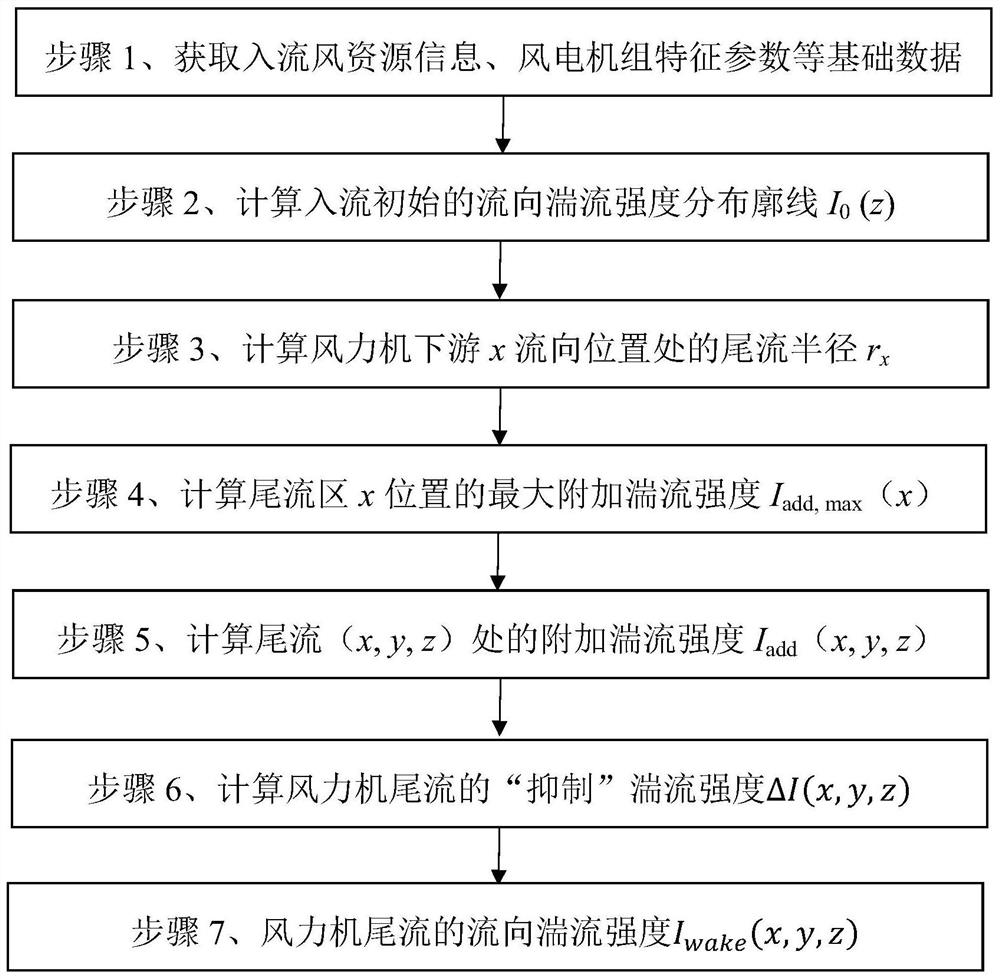Method for calculating turbulence intensity of tail flow of wind turbine
A technology of turbulence intensity and calculation method, which is applied in the field of accurate and fast calculation of wind turbine wake turbulence intensity, and can solve the problems of low calculation model dimension, cumbersome calculation process, and affecting the universality of model application
- Summary
- Abstract
- Description
- Claims
- Application Information
AI Technical Summary
Problems solved by technology
Method used
Image
Examples
Embodiment 1
[0050] The Sexbierum wind farm contains 18 units with a rated power of 310kW, the diameter of the wind rotor D=30m, and the hub height z hub = 35m unit, installed multiple anemometers to measure the wake field and power generation of single and multiple units. For the wake test of a single wind turbine, three typical locations downstream of the unit at 2.5D, 5.5D and 8.0D (including three types of near wake, transitional wake and far wake) are the main measurement objects. Select the wind speed U at the hub height position of the incoming flow 0,hub =8.4m / s, turbulence intensity I 0,hub =10% is the test condition (the corresponding wind profile exponent power α=0.15, surface roughness z 0 =0.078m, wind turbine thrust coefficient Ct=0.75), the turbulence intensity distribution in the wake area of the wind turbine is predicted for it, and the specific steps are as follows:
[0051] (1) Confirm basic data such as inflow wind resource information and characteristic parameters...
Embodiment 2
[0072] In 2009, Chamorro et al. (Chamorro, L.P.; Porté-Agel, F.A wind-tunnel investigation of wind-turbine wakes: Boundary-layer turbulence effects. Bound. Layer Meteorol. 2009, 132, 129–149) carried out wind tunnel experiments on wind turbine wakes Research. The experimental object is a WiRE EP-6030 wind turbine, the diameter of the wind rotor is D=0.15m, and the height of the hub is z hub =0.125m, mainly observe the distribution of flow variables at the downstream (x / D=3,5,7,10,14,20) equi-section positions. The incoming flow condition is the wind speed U at the height of the hub 0,hub =2.2m / s, turbulence intensity I 0,hub =7.0% (at this time, the corresponding wind profile exponent power α=0.15, surface roughness z 0 =2.5×10 -5 m, wind turbine thrust coefficient Ct=0.56). The distribution of the turbulence intensity distribution in the wake of the wind turbine is predicted for this working condition.
[0073]The calculation steps used in this embodiment are the same a...
Embodiment 3
[0075] In 2015, Troldborg et al. (Trldborg N, J An improved k-e modelapplied to a wind turbine wake in atmospheric turbulence.2015,18:889-907) carried out a high-precision numerical simulation of the wake of a single NREL 5MW wind turbine using the AD / LES method. Wind wheel diameter D = 126m, hub height z hub = 90m, mainly focus on downstream (x / D=2.5, 5 and 7.5) equal sections. Incoming flow hub height position wind speed U 0,hub =8.0m / s, turbulence intensity I 0,hub =4.0% (at this time, the corresponding wind profile exponent power α=0.10, and the thrust coefficient Ct of the wind turbine=0.79). The distribution of the turbulence intensity distribution in the wake of the wind turbine is predicted for this working condition.
[0076] The calculation steps adopted in this embodiment are the same as those in Embodiment 1, and the calculated distribution of turbulence intensity along the y direction at three typical positions is as follows: Figure 7 As shown, it can be se...
PUM
| Property | Measurement | Unit |
|---|---|---|
| Height | aaaaa | aaaaa |
Abstract
Description
Claims
Application Information
 Login to View More
Login to View More - R&D
- Intellectual Property
- Life Sciences
- Materials
- Tech Scout
- Unparalleled Data Quality
- Higher Quality Content
- 60% Fewer Hallucinations
Browse by: Latest US Patents, China's latest patents, Technical Efficacy Thesaurus, Application Domain, Technology Topic, Popular Technical Reports.
© 2025 PatSnap. All rights reserved.Legal|Privacy policy|Modern Slavery Act Transparency Statement|Sitemap|About US| Contact US: help@patsnap.com



